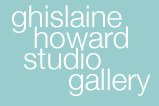| GHISLAINE HOWARD 365 daily images 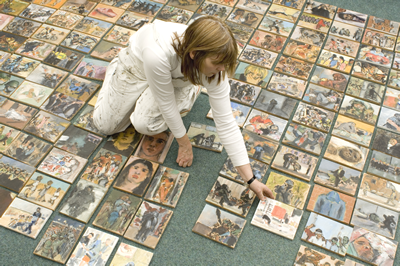 Online catalogue for the
exhibition at the WaterWay, Online catalogue for the
exhibition at the WaterWay,Imperial War Museum North, The Quays, Trafford Wharf Road, Manchester, M17 1TZ The exhibition ran from March until September 2009. Imperial War Museum North's press release Press images (PDF); press composite (PDF) by Stephen Yates |
T S Eliot once wrote that human beings cannot bear too much reality; W H Auden reminded us that suffering takes place whilst no-one is paying any especial attention and that despite everything, life goes on – these images lie somewhere between those two statements. 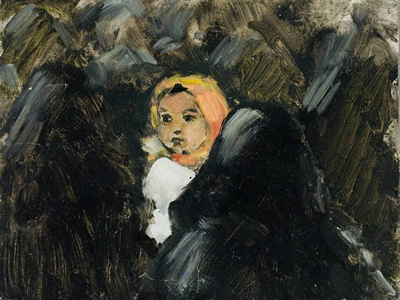 Talking about the work, Ghislaine has said: "I
was in London on the 7 July 2005 and like so many others I was caught
up in the chaos and anxiety of that day. When I returned to my studio I
felt compelled to work through the experience in paint. Reading about
the day in my daily paper I was struck by photographs in which the
familiar streets of London had become the backdrop to horror.
"At that time I made a number of small paintings in response to these images and, almost without realizing it, I had begun what would become a daily practice. Each day I choose one image (usually from the Guardian) that strikes a particular chord with me and make a small painting from it. Each panel is 6 x 8 inches. I try to paint them as simply and as lovingly as I can. They have become an act of vigil – a way of giving time back to these images and the individuals represented in them. Feeling powerless in the face of world events, this is one thing I can do. "When I started making the series I intended to continue each day for a year - now I see no reason to stop." 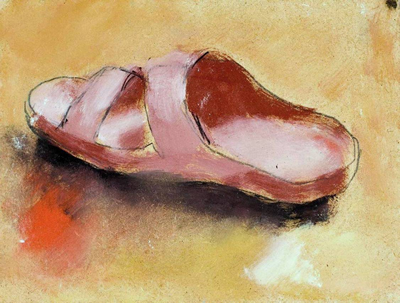 The choice of paintings presented in the exhibition, 365, reflects the preponderance of images of warfare, crime and suffering that we find on a daily basis in our newspaper of choice. For Ghislaine, the choosing of the images is intuitive: not every one relates to scenes of tragedy. Each is dated on the reverse, but other than that, no further reference is made to the wider context of which they are a part. The following paragraphs spring from conversations between Ghislaine and myself over the time the works have been created; we hope they may add to your experience of the exhibition and provide stimulus for further thought.  These works spring from a dual need: to bear witness and to affect some kind of palpable response in the viewer to events that seem at times beyond our comprehension. The philosopher, George Klein has written in the culminating chapter of his book Pietà, how walking through the Christian quarter of Jerusalem he caught sight of an inscription beneath a relief of the crucified Christ, O vos omnes, qui travistis per viam, attendite et videte si est dollar sicut dolor meus (All you who pass this way, look and see: is there any sorrow like the sorrow that afflicts me) Lamentations, 1.12 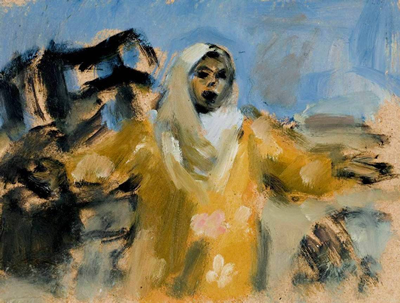 Our technology allows us instant access to a constant flow of images and news items: we are all of us witnesses. How should we counter the weariness brought on by the repeated exposure to such images of violence or degradation? These images, how they repeat themselves: each day more images arrive and each day the paper partly read, goes in the recycling bin or on the fire. The photographs disappear with it, only to re-appear in a slightly different form the next day. It is startling to realise just how often these ephemeral images taken from real lives, echo compositional motifs familiar to us in the work of those artists we admire – Michelangelo, Titian, Goya and Delacroix, for example. By bringing these images back from their ephemeral existence and giving them some kind of permanence as paintings, Ghislaine closes the circle – reminding us of the constancy of human gestures and experience. 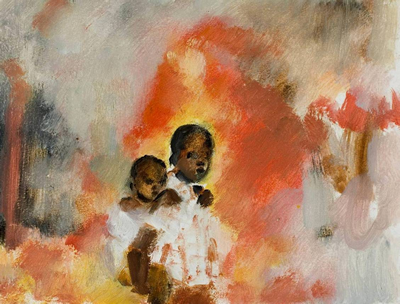 The exhibition represents a notional year of images culled from more than 500 panels. Each one touches in some way on particular moments of tragedy or exultation in the lives of specific individuals. Yet in creating these paintings it has become evident just how little we really know about what is depicted. It is difficult to shrug off the feeling that one is intruding in these moments. What do we know about the events that led up to that frozen moment, the two boys, brothers perhaps, who have been caught in the camera lens framed by a burning fire. By the time we see the image, seated at the breakfast table, reading on the train or in a café, the event pictured has already happened and things have continued to unfold. These images taken as a whole remind us of the sheer callousness of violence – its barbarity. The photographs from which the works derive address our tragic sense of life and evoke feelings of pity (pietà) for those who suffer. Perhaps these paintings may help to arouse a shared feeling of our fragility of what it is to be human. 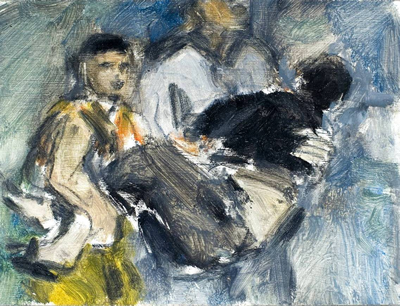 The violence of a single moment is reduced in these works to a series of formal pictorial structures. This process removes the image from the immediacy associated with photography and in so doing perhaps, allows the spectator a space in which to contemplate at a remove, the significance of the event represented. The paintings as a whole invite the viewer to create their own narrative from the assembled 365 works. Hindered by the lack of accompanying information, one is inevitably forced to fall back on remembered and half-remembered news items from the recent past. Such actions might remind us of the importance of the context in which the original photographs were encountered. How much knowledge is actually available to us? Knowledge is one thing - understanding another. In these works there is nothing that is self-evident. Any intervention of text may clarify or explain, but it also interprets and can mislead in equal measure. These works tell us that suffering is entirely specific. A tragic event witnessed at second or even first hand is not the 'same' experience as the one the people undergoing the original experience endure; however much we may empathise. Perhaps a fitting place to end is not an image but paradoxically a piece of text. We have chosen an extract from Shakespeare's Macbeth. It is a play centred on violence, greed, ambition, love and hate. Late in the play, with more violence to follow: Malcolm, the rightful heir to the Scottish throne, and Macduff are met by Ross. Macduff's wife and family have been slaughtered; he is as yet unaware of this fact. MALCOLM What's the newest grief?
ROSS That of an hour's age doth hiss the speaker: each minute teems a new one... Your castle is surprised; your wife and babes savagely slaughter'd... MACDUFF My children too? ROSS Wife, children, servants, all that could be found... MACDUFF All my pretty ones? Did you say all? O hell-kite! All? What, all my pretty chickens and their dam at one fell swoop? Somehow Shakespeare captures in the words and the spaces between the words the terrible things human beings do to each other and our ability is some measure to give form to the sheer fragility of human experience. Perhaps in their abundance, these paintings do something similar, bear witness to horror but recognise our ability to picture that horror and in doing so, perhaps, move towards some kind of possible resolution Michael Howard
|
365 catalogue
